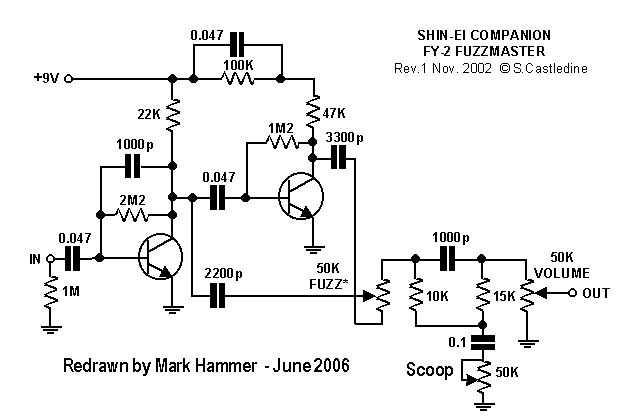A
Anonymous
Guest
salü
Mir ist da vorhin ein (einfacher) Schaltplan zu nem Fuzz unter die Finger gekommen.
Der benötigt 2sc5368F) Transistoren.
sind die wichtig oder geht da auch was anderes ?
oder gibts was ebensogutes was auch so einfach ist an Schaltplänen ?
von hier:
http://hammer.ampage.org/?cmd=lt&xid=&fid=&ex=&pg=1

Mir ist da vorhin ein (einfacher) Schaltplan zu nem Fuzz unter die Finger gekommen.
Der benötigt 2sc5368F) Transistoren.
sind die wichtig oder geht da auch was anderes ?
oder gibts was ebensogutes was auch so einfach ist an Schaltplänen ?
von hier:
http://hammer.ampage.org/?cmd=lt&xid=&fid=&ex=&pg=1

hammer.ampage.org schrieb:I acquired a Shin-Ei FY-2 fuzz in 1992 or so. I had bought it for $20 from a second hand store, largely because it had a decent case and stompswitch and buying either of those where I was living at the time would have cost me at least $30. Having a naively lesser opinion of 60's fuzzes at the time, I ripped the circuit board out and built another circuit into the box. The original board sat around for a decade or more until someone finally posted information that let me reconnect the pots to it and fire it up.
Boy was I glad I did. The thing is nasty, sick, fierce and all the other things you want a fuzz to be. It is also a little more maleable than one would think, and VERY easy to build. The unit uses 2SC536F transistors. The F-suffix indicates 536's with hfe values in the 180's to 240's or so. The transistors on mine were around 250, but the values on one I built from scratch were 220 and the difference appears to have no impact.
The stock unit employs a passive mid-scoop filter between the fuzz-generating circuitry and output level control. While this injects the right amount of sinister tone (like a Superfuzz), it isn't always what you want. The scooping depends on passive loss through a 0.1uf cap. If you reduce the bleed through that cap to ground, you end up increasing the lower and upper mids and increasing the "body" of the sound. I inserted a 50k pot on mine (shown in the schematic) between the 0.1uf cap and ground. Alternatively, if the entire scoop circuit is bypassed and replaced with a fixed value resistor, you get the "full bandwidth" fuzz tone without any tone shapping.